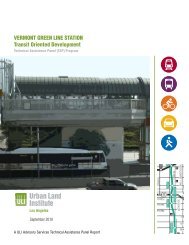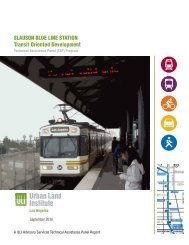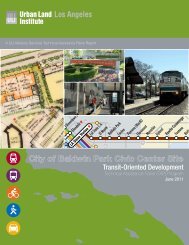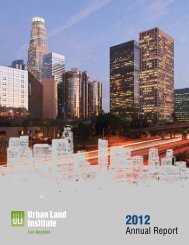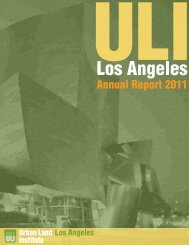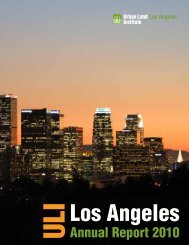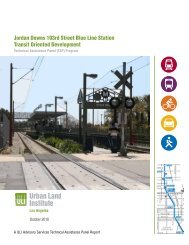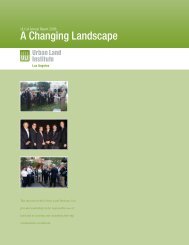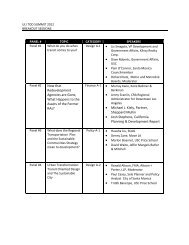Rosebowl - ULI Los Angeles - Urban Land Institute
Rosebowl - ULI Los Angeles - Urban Land Institute
Rosebowl - ULI Los Angeles - Urban Land Institute
Create successful ePaper yourself
Turn your PDF publications into a flip-book with our unique Google optimized e-Paper software.
A Governors Advisory Panel Report<br />
The Rose Bowl and<br />
Central Arroyo Seco<br />
Pasadena, California<br />
Strategies for an Iconic <strong>Land</strong>mark and Its Surrounding Area<br />
January 30–February 2, 2012
2<br />
About the <strong>Urban</strong> <strong>Land</strong> <strong>Institute</strong><br />
The mission of The URbAn LAnd insTiTUTe is<br />
to provide leadership in the responsible use of land and in<br />
creating and sustaining thriving communities worldwide.<br />
<strong>ULI</strong> is committed to<br />
n Bringing together leaders from across the fields of real<br />
estate and land use policy to exchange best practices<br />
and serve community needs;<br />
n Fostering collaboration within and beyond <strong>ULI</strong>’s<br />
membership through mentoring, dialogue, and<br />
problem solving;<br />
n Exploring issues of urbanization, conservation, regeneration,<br />
land use, capital formation, and sustainable<br />
development;<br />
n Advancing land use policies and design practices<br />
that respect the uniqueness of both built and natural<br />
environments;<br />
n Sharing knowledge through education, applied research,<br />
publishing, and electronic media; and<br />
n Sustaining a diverse global network of local practice<br />
and advisory efforts that address current and future<br />
challenges.<br />
Established in 1936, the <strong>Institute</strong> today has nearly 30,000<br />
members worldwide, representing the entire spectrum of<br />
the land use and develop ment disciplines. Professionals<br />
represented include developers, builders, property own ers,<br />
investors, architects, public officials, plan ners, real estate<br />
brokers, appraisers, attorneys, engineers, financiers,<br />
academicians, students, and librarians.<br />
<strong>ULI</strong> relies heavily on the experience of its members. It is<br />
through member involvement and information resources<br />
that <strong>ULI</strong> has been able to set standards of excellence in<br />
de velopment prac tice. The <strong>Institute</strong> has long been rec-<br />
ognized as one of the world’s most respected and widely<br />
quoted sources of objective information on urban planning,<br />
growth, and development.<br />
© 2012 by the <strong>Urban</strong> <strong>Land</strong> <strong>Institute</strong><br />
1025 Thomas Jefferson Street, NW<br />
Suite 500 West<br />
Washington, DC 20007-5201<br />
Cover photo: City of Pasadena.<br />
All rights reserved. Reproduction or use of the whole or any<br />
part of the contents without written permission of the copyright<br />
holder is prohibited.<br />
A Governors Advisory Panel Report
About <strong>ULI</strong> Advisory Services<br />
The GoAL of ULi’s Advisory Services Pro gram is to<br />
bring the finest expertise in the real estate field to bear<br />
on complex land use planning and development projects,<br />
programs, and policies. Since 1947, this program has<br />
assembled well over 400 <strong>ULI</strong>-member teams to help<br />
sponsors find creative, practical solutions for issues such<br />
as downtown redevelopment, land management strategies,<br />
evaluation of development potential, growth management,<br />
community revitalization, brownfields redevelopment,<br />
military base reuse, provision of low-cost and affordable<br />
housing, and asset management strategies, among other<br />
matters. A wide variety of public, private, and nonprofit<br />
organizations have contracted for <strong>ULI</strong>’s Advisory Services.<br />
Each panel team is composed of highly qualified professionals<br />
who volunteer their time to <strong>ULI</strong>. They are chosen<br />
for their knowledge of the panel topic and screened<br />
to ensure their objectivity. <strong>ULI</strong>’s interdisciplinary panel<br />
teams provide a holistic look at development problems.<br />
A re spected <strong>ULI</strong> member who has previous panel experience<br />
chairs each panel.<br />
The agenda for a panel assignment is in tensive. It includes<br />
an in-depth briefing composed of a tour of the site<br />
and meetings with spon sor representatives; hour-long<br />
interviews of key community representatives; and a day of<br />
formulating recommendations. Long nights of discussion<br />
precede the panel’s conclusions. On the final day on site,<br />
the panel makes an oral presentation of its findings and<br />
conclusions to the sponsor. A written re port is pre pared<br />
and published.<br />
Because the sponsoring entities are responsible for significant<br />
preparation before the panel’s vis it, including sending<br />
extensive briefing materials to each member and arranging<br />
for the panel to meet with key local community members<br />
and stakeholders in the project under consideration,<br />
participants in <strong>ULI</strong>’s panel assignments are able to make<br />
accurate assessments of a sponsor’s issues and to provide<br />
recommendations in a compressed amount of time.<br />
A major strength of the program is <strong>ULI</strong>’s unique ability<br />
to draw on the knowledge and expertise of its members,<br />
including land developers and owners, public officials,<br />
academicians, representatives of financial institutions,<br />
and others. In fulfillment of the mission of the <strong>Urban</strong> <strong>Land</strong><br />
<strong>Institute</strong>, this Advisory Services panel report is intended to<br />
pro vide objective advice that will promote the re spon sible<br />
use of land to enhance the environment.<br />
ULi Program staff<br />
Gayle Berens<br />
Senior Vice President, Education and Advisory Group<br />
Thomas W. Eitler<br />
Vice President, Advisory Services<br />
Annie Finkenbinder Best<br />
Director, Education and Advisory Group<br />
Caroline Dietrich<br />
Panel Associate, Education and Advisory Group<br />
Gwen McCall<br />
Senior Administrative Manager, Education and<br />
Advisory Group<br />
James A. Mulligan<br />
Managing Editor<br />
Joanne Platt, Publications Professionals LLC<br />
Manuscript Editor<br />
Betsy VanBuskirk<br />
Creative Director<br />
Anne Morgan<br />
Graphic Design<br />
Craig Chapman<br />
Senior Director, Publishing Operations<br />
The Rose bowl and Central Arroyo seco, Pasadena, California, January 30–february 2, 2012 3
4<br />
About the <strong>ULI</strong> Foundation<br />
The mission of The ULi foUndATion is to serve<br />
as the philanthropic source for the <strong>Urban</strong> <strong>Land</strong> <strong>Institute</strong>.<br />
The Foundation’s programs raise endowment funds,<br />
major gifts, and annual fund monies to support the key<br />
initiatives and priorities of the <strong>Institute</strong>. Philanthropic gifts<br />
from <strong>ULI</strong> members and other funding sources help ensure<br />
<strong>ULI</strong>’s future and its mission of providing leadership in the<br />
responsible use of land and in creating and sustaining<br />
thriving communities worldwide.<br />
The Foundation exists to support the content development<br />
and dissemination efforts of the <strong>Urban</strong> <strong>Land</strong> <strong>Institute</strong><br />
and to educate the public—and those making decisions<br />
on behalf of the public—about responsible land<br />
use practice and patterns. Whether creating scholarship<br />
opportunities for worthy students, publishing original<br />
research on critical land use issues, or convening decision<br />
makers to discuss current industry developments,<br />
the <strong>ULI</strong> Foundation enables members to make a visible<br />
difference in communities around the world—and in the<br />
lives of countless individuals within those communities.<br />
The <strong>ULI</strong> Foundation has benefited from the generous<br />
philanthropy of many donors, who see in their giving an<br />
opportunity to provide for others through an organization<br />
that has meant so much in their own lives and careers.<br />
Governors<br />
<strong>ULI</strong> governors are a select group of members united by<br />
their commitment to ensuring the future of the organization.<br />
Becoming a governor is one of the most profound<br />
ways to make a visible difference to the future of our<br />
nation’s communities as well as our collective professions.<br />
The Governors Program funds the largest and<br />
most significant endowment for <strong>ULI</strong>. The endowment has<br />
contributed about $2 million during the last three years<br />
to support many key content initiatives.<br />
Governors Advisory Panels<br />
The Governors Advisory Panel (GAP) program is unique in<br />
that the <strong>ULI</strong> Foundation funds the panel completely, with<br />
a gift from governor John S. Hagestad. Like Advisory<br />
Services panels, GAPs are organized as interdisciplinary<br />
panels that can help communities address important<br />
land use and real estate development issues.<br />
Officers<br />
James D. Klingbeil<br />
Chair<br />
Richard M. Rosan<br />
President<br />
Staff<br />
David Howard<br />
Executive Vice President<br />
Andrea Holthouser<br />
Vice President, Individual Giving<br />
Janet Fernandez<br />
Executive Assistant<br />
Jessica Waymouth<br />
Development Team<br />
A Governors Advisory Panel Report
Acknowledgments<br />
The PAneL wishes To ThAnk the city of Pasadena<br />
for hosting this first-ever Governors Advisory Panel.<br />
A special thanks goes to Mayor Bill Bogaard for his<br />
dedication and interest in the panel and the <strong>Urban</strong> <strong>Land</strong><br />
<strong>Institute</strong>. His leadership and involvement in this short<br />
but productive panel process were inspiring. Thanks<br />
also go out to Vice Mayor Margaret McAustin for her<br />
opening remarks at our presentation and City Council<br />
member Victor Gordo, who also serves as chair of the<br />
Rose Bowl Operating Company (RBOC). Their input<br />
was an important step in understanding how the city<br />
operates, and they provided crucial information and<br />
advice that allowed the panel to make clear and achievable<br />
recommendations to help the Rose Bowl and the<br />
Central Arroyo Seco.<br />
In addition, the panel thanks Assistant City Manager<br />
Steve Mermell, Planning Director Vince Bertoni, and<br />
Deputy Planning Director Stephanie DeWolfe. Special<br />
thanks go out to Jason Mikaelian, general plan manager,<br />
and Scott Reimers, planner, whose time and effort<br />
in preparing the briefing materials and the involvement<br />
and coordination of the panel’s interviews and tour<br />
were invaluable. Additional thanks go to Darryl Dunn<br />
and David Sams from the RBOC whose knowledge and<br />
history of the Rose Bowl Stadium and Brookside Golf<br />
Course were invaluable.<br />
Finally, the panel acknowledges the more than 30<br />
individuals who were interviewed. They included representatives<br />
of adjacent neighborhood groups, a variety<br />
of Arroyo users, the business community, RBOC Board,<br />
city staff, and City Council. Representing a diverse<br />
and informed public, the passion and understanding of<br />
these stakeholders provided valuable information and<br />
perspectives, greatly aiding the panel in its analysis.<br />
The Rose bowl and Central Arroyo seco, Pasadena, California, January 30–february 2, 2012 5
Contents<br />
Governors Advisory Panel and Project Staff ...........................................8<br />
Background and the Panel’s Assignment .............................................9<br />
Initial Observations ............................................................13<br />
Primary Recommendations: Three Big Ideas .........................................15<br />
Additional Recommendations ....................................................18<br />
Conclusion .................................................................21<br />
About the Panel ..............................................................22<br />
The Rose bowl and Central Arroyo seco, Pasadena, California, January 30–february 2, 2012 7
8<br />
Governors Advisory Panel and<br />
Project Staff<br />
Panel Chair<br />
Richard L. Perlmutter<br />
Managing Partner<br />
Argo Development Company<br />
Rockville, Maryland<br />
Panel Members<br />
Ryan Bouma<br />
Senior Associate<br />
AECOM<br />
Alexandria, Virginia<br />
Susan Hudson-Wilson<br />
Hawkeye Partners LP<br />
Chebeague Island, Maine<br />
Richard M. Rosan<br />
President, <strong>ULI</strong> Foundation<br />
<strong>Urban</strong> <strong>Land</strong> <strong>Institute</strong><br />
Washington, D.C.<br />
Frank Stanek<br />
President<br />
Stanek Global Advisors<br />
Arroyo Seco, California<br />
<strong>ULI</strong> Staff<br />
Thomas W. Eitler<br />
Vice President, Advisory Services<br />
<strong>Urban</strong> <strong>Land</strong> <strong>Institute</strong><br />
Washington, D.C.<br />
A Governors Advisory Panel Report
Background and the Panel’s Assignment<br />
ULi <strong>Los</strong> AnGeLes PResenTed the opportunity for<br />
a panel at the Rose Bowl, focusing on the upcoming<br />
renovations to the stadium and the myriad issues<br />
surrounding the uses of the Central Arroyo Seco, which<br />
surrounds the stadium. The city of Pasadena prepared<br />
a series of questions that formed the scope of work<br />
for the panel and prepared briefing materials that were<br />
forwarded to the panelists.<br />
The panel convened on January 30, 2012, and presented<br />
its recommendations to the city on February 2, 2012.<br />
The City of Pasadena<br />
Pasadena, California, is a city of 137,000 located about<br />
ten miles northeast of downtown <strong>Los</strong> <strong>Angeles</strong>. Known as<br />
the home of the California <strong>Institute</strong> of Technology (Caltech)<br />
and the Jet Propulsion Laboratory, the city’s history is<br />
steeped in the success of higher education, its early<br />
20th-century destination as a vacation location for wealthy<br />
easterners, and its connection with the Tournament of<br />
Roses Parade and the associated Rose Bowl college football<br />
game. With a median household income of $65,422,<br />
the city is considered a higher-income area compared with<br />
the rest of the surrounding <strong>Los</strong> <strong>Angeles</strong> suburbs.<br />
The Rose Bowl and the Central<br />
Arroyo Seco<br />
The Arroyo Seco, a major tributary of the <strong>Los</strong> <strong>Angeles</strong><br />
River, flows out of the San Gabriel Mountains in the<br />
northwestern corner of Pasadena and empties into the<br />
river in downtown <strong>Los</strong> <strong>Angeles</strong>. As its waters flow through<br />
the city, the river passes through three distinct geographical<br />
areas: the Upper Arroyo (Hahamongna Watershed<br />
Park), the Central Arroyo (the Rose Bowl, Brookside Golf<br />
Course, and Brookside Park), and the Lower Arroyo.<br />
Rose bowl<br />
Built in 1922, Rose Bowl Stadium is a National Historic<br />
<strong>Land</strong>mark. Known mainly for the annual New Year’s Day<br />
Rose Bowl Game, the stadium is also the proud home of<br />
UCLA Bruins football, Fourth of July celebrations, and a<br />
monthly flea market. Rose Bowl Stadium can seat more<br />
than 90,000 people; in 2009, over 750,000 visitors attended<br />
events. The maximum number of “displacement”<br />
events is 12 events annually. A displacement event is one<br />
that is projected to have more than 25,000 attendees.<br />
In addition to the annual Rose Bowl Game, the stadium<br />
has been the site of five NFL Super Bowl games, Olympic<br />
events (1932 and 1984), the Men’s World Cup (1994),<br />
the Women’s World Cup (1999), BCS National College<br />
Football Championship games (2002 and 2006), and<br />
many other events.<br />
A view of the Rose Bowl<br />
and Central Arroyo Seco<br />
from the south.<br />
The Rose bowl and Central Arroyo seco, Pasadena, California, January 30–february 2, 2012 9
10<br />
Location and regional maps.<br />
Rose bowl <br />
Pasadena<br />
In October 2010, the Pasadena City Council approved<br />
a $152 million financing plan for a major renovation of<br />
Rose Bowl Stadium. The proposed improvements to the<br />
stadium will add considerably to the fan experience while<br />
maintaining its iconic and historic status. Improvements<br />
include a new press box, removal of clutter along the<br />
stadium rim, a new video board, wider tunnels, added<br />
aisles, an elliptical field, restoration of the historic field<br />
hedge, added concessions, and added restrooms. The financing<br />
comes mostly from city general obligation bonds.<br />
The bonds require annual servicing, and although most<br />
of these funds are expected to generate revenue from the<br />
new press box and improved visitor experience, one of<br />
the panel’s major assignments was to identify additional<br />
potential revenue sources.<br />
The Central Arroyo seco<br />
The Central Arroyo Seco, consisting of 254 acres, is the<br />
most active part of the Arroyo and is generally divided<br />
into three areas: Brookside Golf Course in the north,<br />
Rose Bowl Stadium in the middle, and Brookside Park<br />
to the south.<br />
Brookside Golf Course consists of two 72-par, 18-hole<br />
golf courses. The course attracts 800,000 visitors per<br />
year, making it one of the busiest golf facilities in the<br />
country. The 18,000-square-foot clubhouse includes a<br />
full-service restaurant and lounge, plus four banquet/<br />
meeting rooms that can accommodate 60 to 350 guests.<br />
The clubhouse also includes the John Wells Golf Shop,<br />
consistently ranked in the “Top 100 Golf Shops in<br />
America” by Golf Digest. The facility is in the midst of an<br />
$8.1 million renovation.<br />
Brookside Park includes a variety of recreational uses,<br />
including the Rose Bowl Aquatics Center, the Jackie<br />
Robinson Baseball Stadium, the Kidspace Children’s Museum,<br />
and a variety of playing fields, passive open space,<br />
shelters, and picnic areas.<br />
A Governors Advisory Panel Report
A central organizing feature for the entire Central Arroyo<br />
Seco is the 3.3-mile Rose Bowl Loop that allows<br />
residents and visitors a place to walk, jog, rollerblade, or<br />
bicycle. In addition to numerous five- and ten-kilometer<br />
walking/running events, the Rose Bowl Loop hosts the<br />
Rock n’ Roll Pasadena Half Marathon and the Pasadena<br />
Sprint Triathlon and was the overall finish of the Amgen<br />
Tour of California bicycle race. It is estimated that the<br />
Loop attracts 1.5 million visitors per year.<br />
management of the Central Arroyo seco<br />
Rose Bowl Stadium, Brookside Golf Course, and the<br />
clubhouse are managed by the Rose Bowl Operating<br />
Company (RBOC), a California nonprofit, public benefit<br />
corporation, founded in 1995 by an act of the City Council.<br />
A substantial portion of the revenue for the RBOC<br />
comes from Brookside Golf Course.<br />
Other portions of the Central Arroyo Seco are managed<br />
by the city through either the Human Services and Recreation<br />
Department or Public Works.<br />
The Panel’s Assignment<br />
The <strong>ULI</strong> panel was asked to consider and evaluate how<br />
the city could generate revenues from existing users to<br />
maintain and enhance the Arroyo experience without<br />
displacing existing users and affecting the surrounding<br />
residential neighborhoods. Among the specific questions<br />
presented to the panel were the following:<br />
n What additional revenue-generating amenities could be<br />
provided for existing users (for example, bicycle rentals,<br />
food services, sports shop)?<br />
n What additional revenue-generating programs or<br />
events could be added to attract new users without<br />
affecting the surrounding residential neighborhoods?<br />
n What sponsorships, partnerships, or other similar<br />
opportunities are available that would not require new<br />
services or programs?<br />
n What public investments should be made in the Central<br />
Arroyo Seco to enhance the user experience?<br />
The Governors Advisory<br />
Panel, (from left):<br />
Richard Perlmutter,<br />
Rick Rosan, Frank Stanek,<br />
Susan Hudson-Wilson,<br />
and Ryan Bouma.<br />
The Rose bowl and Central Arroyo seco, Pasadena, California, January 30–february 2, 2012 11
12<br />
n In what ways can the surface parking lots be creatively<br />
used to generate revenues and enhance the<br />
user experience?<br />
n How can the city better capitalize on the Rose Bowl’s<br />
brand or image?<br />
n How can the city better capitalize on tourism generated<br />
by the Rose Bowl and other area attractions<br />
(from existing special events and from general visitors<br />
to the area)?<br />
n How can the city better capitalize on the presence of<br />
the Kidspace Children’s Museum and the Rose Bowl<br />
Aquatics Center?<br />
n How can the golf course and clubhouse be enhanced<br />
to expand revenues and provide better amenities for<br />
existing and new users?<br />
n How can the city creatively address existing issues,<br />
such as traffic, parking, and noise?<br />
Summary of Recommendations<br />
The panel feels that to address these questions and<br />
to accomplish the overall goals of better allocating<br />
resources in an efficient and thoughtful manner, the<br />
city must better manage the entire Central Arroyo Seco,<br />
better coordinate activities, manage scarce resources,<br />
pool financial resources, and improve the overall user<br />
experience. To accomplish these tasks, the panel recommends<br />
that the city immediately<br />
n create a Central Arroyo Conservancy;<br />
n create and manage a Rose Bowl visitors program built<br />
on existing and potential visitor flows; and<br />
n develop a fee-based parking program for the Central<br />
Arroyo.<br />
In addition to these three immediate actions, the city and<br />
conservancy should plan and implement a series of nearand<br />
longer-term Arroyo-wide improvements, including<br />
n redeveloping the clubhouse so that it serves a broader<br />
range of visitors;<br />
n reimagining and reorganizing the golf course, including<br />
xeriscaping, raising greens fees, and coordinating with<br />
other users in the Arroyo;<br />
n reorganizing the parking and playfields; and<br />
n naturalizing the Arroyo Stream.<br />
The remainder of this report summarizes these recommendations.<br />
A Governors Advisory Panel Report
Initial Observations<br />
The sUbJeCT AReA is CenTeRed on a world-<br />
class venue surrounded by a multipurpose park that<br />
cumulatively attracts upward of 2 million visitors<br />
a year. This large, complex, and attractive setting<br />
contributes significantly to the economic, social, and<br />
environmental well-being of the city and the greater<br />
<strong>Los</strong> <strong>Angeles</strong> area. The current goal for the area is to<br />
evolve the Rose Bowl and Central Arroyo Seco into<br />
a self-sustaining entity. Four main points support<br />
the idea that the Central Arroyo could become a<br />
significantly self-sustaining entity supporting the<br />
activities of the Central Arroyo recreational asset:<br />
population, income, brand, and finite physical space.<br />
Population<br />
A large population of users and potential users exists<br />
near the Arroyo, including<br />
n five-minute drive time = population of 47,000;<br />
n within the city limits = population of 137,000;<br />
n ten-minute drive time = population of 436,000; and<br />
n current estimate of perhaps 2 million visitors per year.<br />
Income<br />
In 2010, the median household income in the city of<br />
Pasadena was $65,422, well above U.S. averages.<br />
In a retail analysis, the relevant math is bodies times<br />
dollars. Pasadena has both and so can benefit from the<br />
multiplicative effect of that strength. Education levels<br />
are high as well. These factors suggest that the demand<br />
side of the Pasadena recreational and conservation<br />
markets is unusually strong.<br />
Brand<br />
The Rose Bowl name is iconic and the high ethic of the<br />
Rose Bowl is in decreasing supply. The globe is aware<br />
of the name, even if it is not as aware of the specific<br />
game and the parade. Visitors to the area commonly<br />
go to the front of the stadium and take a picture of the<br />
iconic script and rose through the chain-link fence.<br />
Also, college football fans from all over the country<br />
know which teams and which ultimate NFL stars have<br />
played in a bowl game. The stadium brand is reinforced<br />
by the parade, and the logo is attractive and speaks<br />
for itself. (Note: Other famous bowl stadiums, including<br />
the Sugar Bowl and Orange Bowl, have literally been<br />
destroyed, increasing the value of the Rose Bowl.)<br />
Finite Physical Space<br />
The Central Arroyo Seco is unambiguously physically<br />
constrained on all sides by residential neighborhoods.<br />
There are virtually no other comparable recreational<br />
spaces within a reasonable drive time. For example,<br />
n The competitive recreational space cannot be added<br />
to or created.<br />
n Every square inch needs to be planned for; there is<br />
no room for spurious uses.<br />
n Overuse is damaging to the users’ experience and<br />
constrains the availability further.<br />
The challenge is to serve the most users most<br />
effectively while minimizing conflicts of enjoyment<br />
and ensuring safety.<br />
The Rose bowl and Central Arroyo seco, Pasadena, California, January 30–february 2, 2012 13
14<br />
An aerial view of the Rose<br />
Bowl and Central Arroyo<br />
Seco. Improved asphalt<br />
parking spaces total 5,815,<br />
and parking on turf ranges<br />
from 15,466 to 18,430<br />
additional spaces.<br />
sR 134<br />
i-210<br />
A Governors Advisory Panel Report
Primary Recommendations: Three Big Ideas<br />
The PAneL beLieves that three near-term recom-<br />
mendations can be useful in addressing some of the immediate<br />
issues regarding revenue and site management.<br />
The specific approach for each will have to be deliberated<br />
by the city. But in general terms, these recommendations<br />
provide a strategic path forward for the next few months.<br />
Establish the Central<br />
Arroyo Conservancy<br />
The panel believes that the ultimate goal is to have the<br />
Rose Bowl and Central Arroyo Seco operate as a selfsustaining<br />
entity. The panel believes that the current<br />
organizational approach, with duties and responsibilities<br />
fractured among several entities, can be enhanced by<br />
establishing a Central Arroyo Conservancy. This new<br />
not-for-profit body can be modeled on the concept so<br />
successfully implemented for New York City’s Central<br />
Park. That conservancy has transformed Central Park<br />
into one of the most impressive parks in the world.<br />
Created and empowered by the city of Pasadena, the<br />
conservancy would be a single-purpose 501(c)(3) entity<br />
with operational control of the entire Central Arroyo<br />
area. The RBOC would be either folded into or replaced<br />
by this new entity. The two 501(c)(3) organizations—the<br />
Rose Bowl Aquatics Center and the Kidspace Children’s<br />
Museum—would remain independent and would be in<br />
effect “tenants” of the conservancy.<br />
The conservancy will not be an “authority” but rather a<br />
creature of the city of Pasadena. It would be structured<br />
under a lease from the city to it and would be<br />
controlled by a board with representatives of the City<br />
Council, the mayor’s office, and city departments.<br />
It would have public members as representatives of<br />
The Central Arroyo Seco is<br />
generally divided into three<br />
areas: (top); Brookside Golf<br />
Course; and Rose Bowl<br />
(middle); and Brookside<br />
Park, Kidspace Children’s<br />
Museum, and Rose Bowl<br />
Aquatics Center (bottom).<br />
The Rose bowl and Central Arroyo seco, Pasadena, California, January 30–february 2, 2012 15
16<br />
Among the proposed<br />
renovations to the<br />
Rose Bowl is a<br />
significantly expanded<br />
press box to provide<br />
opportunities for<br />
enhanced premium<br />
seating and its<br />
associated revenue.<br />
the community, primarily citizens of Pasadena, with<br />
perhaps some representation from a broader group of<br />
stakeholders. The conservancy would be designed to<br />
be completely transparent in its actions, and the city<br />
would control the lease terms and renewals. The Central<br />
Park Conservancy in New York City revives a lease<br />
for between eight and ten years, which is renewable.<br />
The primary job of the Central Arroyo Conservancy<br />
would be to manage nearly all aspects of the Central<br />
Arroyo (sanitation and police services may well stay<br />
with the city). The conservancy would have at least the<br />
following responsibilities:<br />
n Create a physical master plan for the Central Arroyo’s<br />
future with both short- and long-term projects, including<br />
new capital and land restoration.<br />
n Create a business plan for the Central Arroyo, including<br />
the Rose Bowl, the golf course, the parking, and<br />
park features. This financial plan would cover both the<br />
short term and long term, including the management<br />
of the revenues, as well as strategies for obtaining new<br />
revenue sources, philanthropic contributions, and an<br />
endowment for needed capital improvements.<br />
n Create a programming template for ongoing activities<br />
of the Central Arroyo with operational goals and<br />
management objectives.<br />
The conservancy can also act as the liaison, coordinator,<br />
and representative with other important groups,<br />
such as the Arroyo Seco Foundation and other government<br />
and private bodies whose interest lies in the park.<br />
The conservancy can also serve as a connection for the<br />
various initiatives that are currently underway, such as<br />
the Central Arroyo Stream Restoration Program and the<br />
Central Arroyo Seco Master Plan.<br />
Rose Bowl Enhancement<br />
Every day, thousands of people visit the Central Arroyo<br />
Seco. Many of them are from outside southern California,<br />
and they inevitably end up visiting the gate of the Rose<br />
Bowl and taking a picture through the fence. Many of<br />
these visitors would love to have the chance to see the<br />
interior of the stadium and stand on the 50-yard line.<br />
The Rose Bowl brand is so universal that the panel feels<br />
that it can be leveraged in a variety of ways to generate<br />
revenue. The controlling entity should create a visitors<br />
program built on existing and potential visitor flows.<br />
Tour and interactive Legends Attraction<br />
A variety of iconic landmarks and locations around the<br />
country use tours as a means to raise revenue. For<br />
example, the Empire State Building and Yankee Stadium<br />
in New York, Cowboys Stadium in Dallas, the Louisville<br />
Slugger Museum in Kentucky, and Lambeau Field in<br />
Green Bay, Wisconsin, all have tour programs that generate<br />
substantial revenue. The Lambeau Field tour regularly<br />
generates upward of $800,000 in revenue. (Lambeau is<br />
located in northern Wisconsin. Although the Packers have<br />
an immense national following, Pasadena in particular<br />
and southern California in general have many more visitors<br />
than Green Bay.)<br />
A Governors Advisory Panel Report
Approaches the tour could take include the following:<br />
n locker room, training facilities;<br />
n historic event location, field walk-on;<br />
n “Catch a Pass” in the end zone;<br />
n “Hold Your Wedding” on the 50-yard line;<br />
n photo ops, take-home and/or digital dissemination;<br />
n interactive attractions; and<br />
n snack and food service.<br />
Tours should also be combined with a focused merchandizing<br />
and memorabilia strategy. Such a strategy will<br />
require a licensing program and product creation.<br />
In addition to generating revenue, the visitors program<br />
could complement the existing visitor flows into the city<br />
and improve linkages between the Central Arroyo and<br />
downtown and other businesses in Pasadena. The panel<br />
believes that such an approach will enhance and extend<br />
the entire Pasadena Heritage story.<br />
Parking<br />
The panel believes that parking is an untapped potential<br />
revenue source for the city. The number of current and<br />
potential visitors strongly suggests the need to develop a<br />
fee-based parking program.<br />
Tiered Parking fee Program<br />
The parking program could be structured with different<br />
rates for residents, nonresidents, and commercial<br />
users. A decal program is one such approach and could<br />
be implemented rather quickly, although this program<br />
must be approached with the understanding that it<br />
will initially require a focused enforcement program. A<br />
fee-based system provides some control and mitigation<br />
of nonresident users, providing a pay-for-play approach<br />
that is becoming the norm for public recreational facilities<br />
throughout the country. A fee-based system will also<br />
likely reduce the number vehicle trips into the Central Ar-<br />
Courtesy of Green Bay PaCkers<br />
royo Seco because there will be those (both residents and<br />
nonresidents) who may choose to no longer patronize the<br />
park. In addition, this system will foster carpooling and<br />
alternative transportation, such as walking and cycling.<br />
evaluate existing Parking<br />
Depending on how the cars are arranged for parking, offstreet<br />
parking totals range from 21,281 to 24,245 spaces.<br />
Improved asphalt parking spaces total 5,815, and parking<br />
on turf ranges from 15,466 to 18,430 additional spaces.<br />
The panel observed that the existing parking and traffic<br />
flow throughout the Arroyo were fragmented and somewhat<br />
confusing with a variety of asphalt, turf, and dirt surfaces.<br />
A few areas, such as those near the golf club, appear to be<br />
designed for specific populations (that is, golfers). Although<br />
clearly part of the larger stadium contingent for game days,<br />
some parking areas, such as those near the aquatics center<br />
and tennis facilities, are used on non–stadium event days<br />
almost exclusively by those nearby uses. Parallel Loop parking<br />
is regularly used by walkers and cyclists.<br />
The panel feels a comprehensive evaluation of the<br />
parking is a first step toward implementing a fee-based<br />
program. The evaluation will help (1) identify areas that<br />
can be regularly used for fee parking, (2) improve parking<br />
flow, and (3) understand user demand. As will be<br />
noted below, a longer-term approach for both parking<br />
and travel surfaces should be considered as well.<br />
Tours, such as the ones<br />
provided at Lambeau<br />
Field (above), provide<br />
tremendous opportunity<br />
for both revenue and<br />
improved awareness of<br />
the Rose Bowl and its<br />
place in the history and<br />
culture of Pasadena.<br />
The Rose bowl and Central Arroyo seco, Pasadena, California, January 30–february 2, 2012 17
18<br />
Additional Recommendations<br />
The AdvisoRy PAneL PRoCess allows only a<br />
limited amount of time to consider and frame a series of<br />
strategic reconditions. Clearly, the primary focus of the<br />
assignment was to identify additional sources of funding<br />
for the Rose Bowl and Central Arroyo Seco. However,<br />
the panel felt that certain issues and subjects would<br />
improve the long-term position of the Central Arroyo.<br />
Reorganization of the parking around the Rose Bowl could include<br />
a realignment of the stadium entry road to allow more efficient use<br />
of adjoining spaces; impervious parking surfaces with reinforced<br />
turf to support parking, recreation, and stormwater harvesting; and<br />
improved parking flow and striping layouts to maximize use on large<br />
event days.<br />
Reorganization of Parking<br />
and Playfields<br />
As noted above, a comprehensive study that reviews,<br />
reorganizes, and rehabilitates the parking and road<br />
facilities will be an important yardstick to begin prioritizing<br />
future improvements for the Central Arroyo. In<br />
addition, thought should be given to reorganizing the<br />
playfields to make them more efficient. Such a study<br />
will help mightily with the ongoing initiatives, such as<br />
the stream restoration project and the master plan.<br />
Specific subjects that should be addressed with this<br />
study include<br />
n evaluating and upgrading paved and nonpaved<br />
parking areas;<br />
n realigning the stadium entry road to allow more efficient<br />
use of adjoining spaces;<br />
n replacing impervious parking surfaces with reinforced<br />
turf to support parking, recreation, and<br />
stormwater harvesting;<br />
n improving parking flow and striping layouts to maximize<br />
use on large event days;<br />
n identifying and allocating space requirements by<br />
user demand; and<br />
n upgrading lighting and landscaping in parking areas;<br />
considering covering portions of the Central Arroyo<br />
Stream for use as added parking and/or access<br />
roads.<br />
These evaluations and improvements can of course be<br />
phased subject to dedicated parking revenue receipts.<br />
A Governors Advisory Panel Report
Golf Course Clubhouse<br />
The panel interviewed more than 30 individuals as a<br />
part of this assignment; most of those interviewees<br />
where emphatic in their opposition to major new uses<br />
in the Central Arroyo. However, many of those interviewed<br />
felt that redevelopment of the golf clubhouse<br />
was appropriate. The 18,000-square-foot clubhouse<br />
could act as the Central Arroyo’s main meeting location<br />
and could serve more than just the golf community.<br />
The panel recommends redeveloping the clubhouse as<br />
a welcoming destination that supports health and wellness<br />
with uses that include<br />
n bicycle rental/storage;<br />
n refreshments;<br />
n recreation-focused retail;<br />
n meeting space; and<br />
n indoor and outdoor gathering areas.<br />
Golf Course<br />
Brookside Golf Course is the most profitable and one<br />
of the most used recreational components in the<br />
Central Arroyo. The panel believes that the city should<br />
reimagine the golf course to optimize the golf experience<br />
and to enhance the Arroyo’s ecology. In addition<br />
to redeveloping the clubhouse space, two specific<br />
concepts should be considered: (1) reducing and/or<br />
reconfiguring the number of holes to better accommodate<br />
additional amenities and (2) xeriscaping to reduce<br />
water demands. Most important, the fee structure<br />
needs to be reconsidered. This golf course is a public<br />
venue with a wonderful history and legacy and tremendous<br />
local and regional patronage.<br />
The panel believes that the current greens fees are<br />
below the true value of the experience. A sampling of<br />
other public golf courses run by the same company in<br />
the <strong>Los</strong> <strong>Angeles</strong> area shows that the fees for at least<br />
a quarter of the 25 courses are either equivalent to or<br />
higher than the fees for the two courses at Brookside.<br />
From a competitive perspective, an increase could result<br />
in significant additional revenues. (Note: the panel<br />
was not informed of the details of the lease/operational<br />
agreement with American Golf so it is not possible to<br />
speculate on who would receive the additional profit.)<br />
Also, from a purely volume perspective, a rise in<br />
greens fees may result in fewer golfers, reducing traffic<br />
in the Central Arroyo. This effect may also reduce the<br />
physical impact on the golf course.<br />
The panel believes that the<br />
city should reimagine the golf<br />
course to optimize the golf<br />
experience and to enhance<br />
the Arroyo’s ecology. The<br />
clubhouse could act as the<br />
Central Arroyo’s main meeting<br />
location and could serve more<br />
than just the golf community.<br />
The Rose bowl and Central Arroyo seco, Pasadena, California, January 30–february 2, 2012 19
20<br />
The golf course is a public<br />
venue with a wonderful history<br />
and legacy and tremendous<br />
local and regional patronage.<br />
In addition to redeveloping<br />
the clubhouse space, the city<br />
should consider reducing and/<br />
or reconfiguring the number of<br />
holes to better accommodate<br />
additional amenities and<br />
incorporating xeriscaping to<br />
reduce water demands.<br />
The area of focus for naturalization<br />
of the Central Arroyo Stream.<br />
The panel concurs with much of<br />
the recent work focused on the<br />
naturalization of the stream to<br />
enhance ecological systems and<br />
provide unique public amenities.<br />
The Rose Bowl Loop currently<br />
accommodates a variety of<br />
walkers, cyclists, and vehicles<br />
that often come into conflict.<br />
Appropriately, the city has<br />
investigated a variety of methods<br />
to reduce these conflicts.<br />
Naturalize the Stream<br />
The Arroyo Seco supports a thriving natural ecosystem<br />
that includes several native plant communities and<br />
provides shelter, food, and nesting sites for hundreds of<br />
wildlife species. The channelization of the Arroyo Seco<br />
began in the 1930s. Efforts are underway by the city and<br />
local community organizations to protect, enhance, and<br />
restore these ecosystems.<br />
The panel concurs with much of the recent work focused<br />
on the naturalization of the stream to enhance ecological<br />
systems and provide unique public amenities. A portion<br />
of the stream on the southwestern side of the stadium<br />
may better function covered, allowing for more efficient<br />
use of the surface for playfield and/or parking, albeit in<br />
an impervious format.<br />
Traffic Management<br />
Conflicts occur among myriad users on the Rose Bowl<br />
Loop. Daily, the Loop is used by cyclists, skaters, walkers,<br />
runners, strollers, golfers, picnickers, and others.<br />
In addition, the use by the peloton (an integrated unit of<br />
cyclists usually traveling at high speeds) is a potential<br />
hazard that requires attention.<br />
The panel gives the city high marks for investigating a<br />
variety of methods to reduce conflicts among the various<br />
users, the latest being special pavement markings and<br />
flexible bollards that provide a visible separation between<br />
walkers and cyclists. From a purely safety perspective,<br />
the panel recommends that the peloton’s use of the Loop<br />
be limited to specific days and hours, which will ensure<br />
the reduction or elimination of conflicts with motorists,<br />
pedestrians, and golf patrons.<br />
A Governors Advisory Panel Report
Conclusion<br />
The sTRATeGiC ReCommendATions in this<br />
report are an attempt to address the potentially serious<br />
and time-sensitive issues that arise, in part, from the<br />
significant financial commitments made to the Rose Bowl<br />
improvements. From a long-term perspective, these<br />
improvements are necessary for the Rose Bowl to stay<br />
competitive in an increasingly aggressive college bowl and<br />
large-venue marketplace. The physical and managerial<br />
aspects of this treasured icon must evolve, or it will die.<br />
The Central Arroyo Seco Conservancy is a concept that<br />
can provide a path forward for the city in its attempt to<br />
raise funds, manage the park, and provide the arm’slength<br />
leadership that is necessary for success. In such<br />
an arrangement, moral hazard is always a possibility.<br />
Moral hazard arises when an institution does not accept<br />
the full consequences and responsibilities of its actions,<br />
therefore having a tendency to act less carefully than<br />
it otherwise would, leaving another party to hold some<br />
responsibility for the consequences of those actions.<br />
The panel cautions that the ultimate responsibility for<br />
any economic shortfalls in the new conservancy will be<br />
the city’s, yet the day-to-day and strategic decisions<br />
will lie with the conservancy. Therefore, it is important<br />
to establish a strict accountability plan, perhaps a lease<br />
arrangement similar to what is used for Central Park.<br />
The other panel recommendations, including “pay-forplay”<br />
parking, may spark initial resentment and disapproval.<br />
In addition, limiting the peloton’s use of the Loop<br />
will likely be protested by cycling enthusiasts. If the<br />
conservancy also implements the additional long-term<br />
recommendations of the panel, they too may be met with<br />
initial resistance. The panel cautions the conservancy to<br />
be confident about its decisions, to stick to its decisions,<br />
and to endure the noise that will likely follow. The conservancy<br />
will need to be disciplined in choosing among<br />
competing uses and fee structures. It will be important<br />
to thoroughly communicate with the users and others<br />
affected by the changes because like most endeavors in<br />
the public realm, transparency is the key. The protest will<br />
pass and the Central Arroyo Seco will be better for it.<br />
Finally, the panel recommends that the city not be<br />
swayed by the offer to temporarily host the National<br />
Football League. It was the panel’s opinion that such<br />
an effort would be detrimental to the ultimate goal of<br />
making the Central Arroyo Seco a sustainable part of<br />
the Pasadena community.<br />
Pasadena is an incredibly vibrant and progressive community<br />
at the leading edge of technology, education,<br />
urban living, downtown revitalization, and sustainability.<br />
The Central Arroyo Seco and the Rose Bowl are incredible<br />
assets that add to that vibrancy. Those dedicated city<br />
and community leaders interested in their preservation<br />
and enhancement must make bold moves to ensure their<br />
continued survival. The panel believes the recommendations<br />
in this report are a good place to start.<br />
The Rose bowl and Central Arroyo seco, Pasadena, California, January 30–february 2, 2012 21
22<br />
About the Panel<br />
Richard L. Perlmutter<br />
Chair<br />
Rockville, Maryland<br />
Perlmutter cofounded Argo Development Company in<br />
1996. The firm has expertise in developing retail, office,<br />
residential, and urban mixed-use projects. Since its<br />
inception, Argo has acquired or developed over 3 million<br />
square feet of commercial and residential space in the<br />
Washington, New York, and Boston metropolitan areas.<br />
Over Perlmutter’s professional career, he has developed<br />
and managed property valued at over $2 billion. The<br />
firm is strategically aligned with the Foulger-Pratt Companies<br />
and develops and acquires real estate primarily<br />
for its own account.<br />
One of the firm’s noteworthy projects is Downtown Silver<br />
Spring, a 1 million-square-foot mixed-use development<br />
in Montgomery County, Maryland. The development includes<br />
retail, office, hotel, multifamily, and civic venues.<br />
The project received the U.S. Environmental Protection<br />
Agency’s 2008 National Award for Smart Growth<br />
Achievement. The development is a public/private<br />
partnership with Montgomery County, Maryland.<br />
Before founding Argo, Perlmutter held numerous positions<br />
in government and the private sector, including<br />
Bank of America and the U.S. Senate. He is a frequent<br />
speaker and participant on <strong>ULI</strong> panels and workshops<br />
and is a member of numerous boards and the District of<br />
Columbia Bar.<br />
Ryan Bouma<br />
Alexandria, Virginia<br />
Ryan Bouma is a landscape architect, land planner, and<br />
LEED-accredited professional specializing in the design<br />
of sustainable communities and the public spaces<br />
within them.<br />
At AECOM, Bouma acts as both project manager and<br />
lead designer working with private developers and<br />
public agencies on award-winning projects throughout<br />
the United States and abroad. His portfolio includes<br />
landscape architectural and urban regeneration projects<br />
in the Washington, D.C., area, such as the National<br />
Capital Framework Plan, master planning for Poplar<br />
Point, planning for the D.C. United Stadium Complex,<br />
and low-impact streetscapes at the Yards redevelopment,<br />
as well as the Eilan resort and mixed-use<br />
community in San Antonio, Texas. Prior to his practice<br />
with AECOM, Bouma worked in the Wilmington, North<br />
Carolina, office of HadenStanziale PA, where he created<br />
mixed-use developments, recreation amenities, and<br />
unique coastal communities.<br />
Bouma has taught Introduction to <strong>Land</strong>scape Design<br />
and Site Analysis at the George Washington University<br />
and has previously provided technical assistance and<br />
advisory services for <strong>ULI</strong> at the local and national levels.<br />
He is a member of the American Society of <strong>Land</strong>scape<br />
Architects; holds a BA in landscape architecture from<br />
West Virginia University; and has received formal training<br />
in crime prevention through environmental design at<br />
the University of Louisville.<br />
A Governors Advisory Panel Report
Susan Hudson-Wilson<br />
Chebeague Island, Maine<br />
Hudson-Wilson is the retired founder of Property & Portfolio<br />
Research Inc. (PPR), an independent real estate research<br />
and strategy development firm. She sold the firm<br />
to the Daily Mail and General Information (DMGI) in 2002.<br />
She served on the board of PPR from 2002 to 2009<br />
and now serves on the boards of Hawkeye Partners LP,<br />
Market Shield LLC, and Calendar Islands Maine Lobster<br />
LLC. Hudson-Wilson speaks often at industry meetings<br />
and has published extensively, including an article on inflation<br />
and real estate in the fall 2007 Journal of Portfolio<br />
Management. In the fall of 2009, 2007, 2005, and 2003,<br />
she coedited the special issue of the Journal of Portfolio<br />
Management. She was awarded the Pension Real Estate<br />
Association’s Graaskamp Award for Research Excellence<br />
in 1995. She became a Chartered Financial Analyst and<br />
received a BA cum laude in economics from the University<br />
of Vermont and an MA in economics from Boston<br />
University. Hudson-Wilson is a former treasurer, vice<br />
chair, and chair of the Pension Real Estate Association<br />
and is a trustee and governor of the <strong>Urban</strong> <strong>Land</strong> <strong>Institute</strong>.<br />
She is a trustee of the University of Vermont and serves<br />
on several committees, including the Audit Committee<br />
and the Investment Subcommittee. She is a founder, past<br />
president, and fellow of the Real Estate Research <strong>Institute</strong><br />
and a member of Lambda Alpha International. She has<br />
also served on the CFA <strong>Institute</strong>’s Candidate Curriculum<br />
Committee and has been a CFA examination grader. She<br />
serves as a trustee and Executive Committee member of<br />
the Schepens Eye Research <strong>Institute</strong>. She coedited the<br />
book Managing Real Estate Portfolios (1994, Business<br />
One Irwin) and edited Modern Real Estate Portfolio Management<br />
(2000, Frank Fabozzi & Associates).<br />
Richard M. Rosan<br />
Washington, D.C.<br />
Richard M. Rosan is the president of the <strong>Urban</strong> <strong>Land</strong><br />
<strong>Institute</strong> Foundation, which is the philanthropic arm<br />
of the <strong>Urban</strong> <strong>Land</strong> <strong>Institute</strong>. <strong>ULI</strong> is a global nonprofit<br />
education and research institute supported by nearly<br />
35,000 members representing all aspects of land use<br />
and development disciplines. Its mission is to provide<br />
leadership in the responsible use of land and in sustaining<br />
and creating thriving communities worldwide.<br />
The <strong>ULI</strong> Foundation, which has a corpus of more than<br />
$40 million, supports many of the <strong>Institute</strong>’s general<br />
research and education activities, as well as local<br />
programs offered through <strong>ULI</strong>’s district council network.<br />
In addition, the Foundation provides endowments for<br />
specific activities, including those related to workforce<br />
housing, infrastructure, sustainability, and public leadership<br />
in land use.<br />
Rosan recently transitioned full-time into the role of <strong>ULI</strong><br />
Foundation president after stepping aside as chief executive<br />
officer of <strong>ULI</strong> Worldwide. For more than 17 years, he<br />
served simultaneously as <strong>ULI</strong>’s top executive and as the<br />
<strong>ULI</strong> Foundation president. Under his leadership, <strong>ULI</strong> experienced<br />
a fourfold increase in membership, expanded its<br />
global outreach into Europe and Asia, and secured many<br />
new funding sources. Rosan broadened <strong>ULI</strong>’s intellectual<br />
content through the creation of the <strong>ULI</strong> senior resident<br />
fellows program and the funded centers, which are supported<br />
through endowments from the <strong>ULI</strong> Foundation.<br />
Rosan is an architect and a fellow of the American<br />
<strong>Institute</strong> of Architects. Prior to his service at <strong>ULI</strong>, he<br />
spent 22 years in New York City in several capacities,<br />
including 12 years with New York City, concluding with<br />
his service as the city’s economic development director.<br />
Rosan also served for six years as president of the Real<br />
Estate Board of New York, and he spent five years in the<br />
private development business as a project director for<br />
several large New York City development projects.<br />
The Rose bowl and Central Arroyo seco, Pasadena, California, January 30–february 2, 2012 23
24<br />
Frank Stanek<br />
Arroyo Seco, California<br />
Stanek established Stanek Global Advisors in May<br />
2004 to provide strategic and new business development<br />
advisory services to clients in the areas of largescale<br />
land use, leisure, entertainment, and resort<br />
development on a global basis.<br />
Stanek has been active in the leisure/tourism development<br />
and entertainment industry for over 40 years.<br />
His primary focus in recent years has been on international<br />
business development, working extensively in<br />
Asia, Europe, and South America.<br />
Before establishing his consulting practice, Stanek held<br />
key executive positions with both Vivendi-Universal<br />
Entertainment and the Walt Disney Company.<br />
Serving as president, international business development,<br />
he led the international development and<br />
expansion opportunities for Universal Parks & Resorts.<br />
Stanek initiated the development of Universal Studios<br />
Japan in Osaka and the acquisition of Universal<br />
Meditteranea near Barcelona, Spain. He managed<br />
Universal’s expansion into China through Universal<br />
Studios Experience Beijing and through the initiation<br />
of Universal Studios Shanghai.<br />
As vice president, corporate planning, for the Walt<br />
Disney Company, Stanek facilitated the first strategic<br />
plan for the company and was active in setting future<br />
expansion and direction for the company’s business<br />
units. In addition, during his 25 years with the Disney<br />
organization, he was actively involved in all aspects<br />
of new business creation and project development for<br />
the company, including Walt Disney World & Epcot<br />
Center in Orlando, Florida, and Disneyland in Anaheim,<br />
California. He was responsible for the planning,<br />
development, and implementation of Tokyo Disneyland<br />
and spearheaded the development strategy, site<br />
selection, and initiation of Disneyland Paris.<br />
Stanek has served as a director on a number of<br />
Universal Studios joint venture boards. He formerly<br />
served as a director of the United States–Japan<br />
Bridging Foundation, a commissioner of the Japan-<br />
U.S. Friendship Commission, and a director of<br />
CULCON, all of which operate under the auspices<br />
of the U.S. State Department. Stanek is a governor<br />
of the <strong>ULI</strong> Foundation, an honorary member and<br />
former trustee of the <strong>Urban</strong> <strong>Land</strong> <strong>Institute</strong>, and a<br />
member of the Board of Advisors for the Hollywood<br />
Entertainment Museum. Additionally, he is a director<br />
of the Ryman-Carroll Foundation and is founding<br />
chair of the Business First Board of California State<br />
University, Fullerton.<br />
Stanek received a BA in business administration from<br />
California State University, Fullerton, in 1964.<br />
A Governors Advisory Panel Report
1025 Thomas Jefferson Street, NW<br />
Suite 500 West<br />
Washington, DC 20007-5201<br />
♼ Printed on recycled paper.



